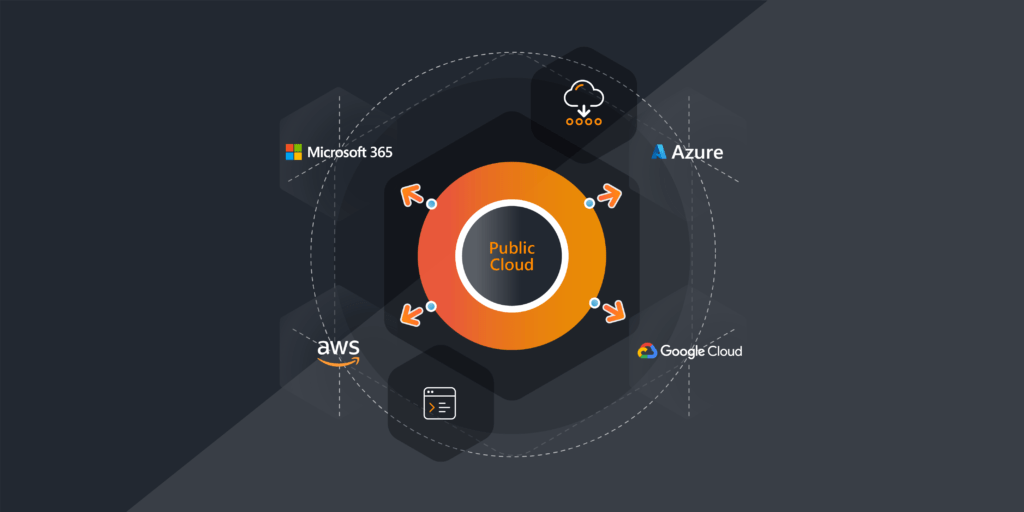
Introducing Lansweeper’s 2024 Summer Launch
Cloud discovery is a critical first step in cataloging and managing all resources, services, and assets deployed within a public cloud environment. It allows you to take inventory of your virtual IT estate and typically includes details about virtual machines, storage instances, databases, networking components, and various cloud services used by an organization.
Comprehensive cloud discovery is essential for providing visibility, control, and optimization of all of your cloud resources. The resulting inventory can also be used for enhancing security and compliance, as well as managing IT spending.
Essential data gathered in Cloud Discovery includes:
- Details about active and inactive virtual machines (VMs), including their specifications, operating systems, and usage statistics.
- Information about cloud storage resources, including object storage, block storage, and file storage.
- Inventory of managed database services, NoSQL databases, and data warehouses.
- Details about virtual networks, subnets, firewalls, load balancers, and VPNs used to secure and manage network traffic.
- Information on various cloud services such as serverless functions, container services, and AI/ML services.
- Monitoring and documentation of security configurations, compliance policies, identity and access management (IAM) roles, and permissions.
- Documentation of resource usage and associated costs to optimize spending and budget management.
- Cloud-based application services, APIs, and microservices deployed within the cloud.
This information is essential for IT governance, resource optimization, compliance, and cloud security.
Key Concepts of Cloud Discovery
Cloud discovery is a foundational component of cloud asset inventory and management. By identifying and cataloging all resources and services deployed within a cloud infrastructure, you can simplify and support any asset management decisions with real actionable data.
This process is crucial for organizations to gain comprehensive visibility into their cloud usage, ensuring that no asset is overlooked. Effective asset discovery tools automatically detect virtual machines, storage solutions, databases, networking components, and other cloud services, providing a detailed inventory. With a detailed and complete cloud asset inventory, organizations gain a clear understanding of their cloud footprint, which helps with managing and governing all of their cloud resources.
Once all of the cloud assets are discovered, it’s important to continually monitor and update the inventory, using continuous surveillance of performance and usage. Any changes – scaling up or down, launching new services, or decommissioning resources – should be recorded, so that teams have the information they need to identify unauthorized changes or potential security risks.
Analysis is also key. Organizations can leverage their cloud asset data to gain valuable insights into resource utilization and health. They can examine patterns and trends to pinpoint underutilized or idle resources and slash unnecessary costs.
Through regular analysis and optimization, organizations can maximize the value of their cloud investments while maintaining high performance and security standards.
Best Practices for Cloud Asset Data Retention
Establishing clear retention policies that align with operational needs and regulatory requirements is critical for effective cloud asset data retention. Automated backup solutions that capture snapshots of inventory data at regular intervals help to preserve historical records. Cloud-native tools for data retention work best, and streamline searchability and management by using metadata tagging.
Retention is critical for effective data governance, which is in turn essential for compliance with regulations such as GDPR and HIPPA. Organizations must be able to prove compliance with strict access controls, audit procedures and data encryption policies for protecting sensitive data.
Strategically managing historical inventory records means using lifecycle management policies to move data through different storage tiers based on its age and how often it’s used. Regularly clearing out old data helps keep storage costs down, while periodic reviews make sure the data you keep is accurate and relevant. Keeping historical records well-organized supports operational insights and better decision-making, boosting overall efficiency.
Choosing the Right Cloud-Based Discovery Software
When evaluating cloud-based asset discovery systems, look for features that ensure comprehensive visibility, ease of use, and seamless integration. The solution should offer automated discovery and continuous tracking of all cloud resources, providing a complete and up-to-date inventory.
Scalability is also essential for handling different types of workloads in your expanding cloud environment, as is support for robust data security measures, such as encryption and access controls. Integration capabilities are key, as the solution must work seamlessly with other IT management and cybersecurity tools to eliminate data silos and streamline operations.
Lastly, ease of implementation is vital; the solution should be user-friendly and quick to deploy, minimizing disruptions to existing workflows.
Start Your Cloud Discovery With Lansweeper
Since it meets all of the above requirements, Lansweeper is an excellent choice for Cloud Discovery tool. Its automated discovery capabilities ensure that all cloud resources are identified and tracked continuously, providing a complete and accurate cloud inventory.
Lansweeper connects seamlessly to your existing systems – CMDB, ITSM, cybersecurity tools, and more – eliminating data silos and reducing the operational overhead of managing multiple systems. Designed for easy implementation, Lansweeper helps organizations optimize their cloud environments and maintain compliance with industry standards.
Learn more about Lansweeper’s solution for cloud asset inventory and management today.
Transform Cloud Discovery Today!
Try out for yourself with a 14-day free trial.
Try Now